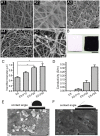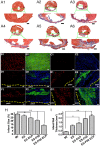Mussel-inspired conductive nanofibrous membranes repair myocardial infarction by enhancing cardiac function and revascularization
- PMID: 30429892
- PMCID: PMC6217052
- DOI: 10.7150/thno.27760
Mussel-inspired conductive nanofibrous membranes repair myocardial infarction by enhancing cardiac function and revascularization
Abstract
The controversy between polypyrrole's (Ppy) biocompatibility and its aggregation on nanofibers impedes application of conductive Ppy-incorporated nanofibers to create engineered cardiac microenvironments. The purpose of this study was to fabricate a functional scaffold for engineering cardiac patches (ECP) using a high concentration of methyl acrylic anhydride-gelatin (GelMA)-Ppy nanoparticles, mussel-inspired crosslinker, and electrospun (ES)-GelMA/polycaprolactone (PCL) nanofibrous membrane. Methods: First, spherical GelMA-Ppy nanoparticles were obtained when the methacrylate groups of GelMA formed a self-crosslinked network through oxidative polymerization of Ppy. Second, GelMA-Ppy nanoparticles were uniformly crosslinked on the ES-GelMA/PCL membrane through mussel-inspired dopamine-N'N'-methylene-bis-acrylamide (dopamine-MBA) crosslinker. Finally, the feasibility of the dopa-based conductive functional ECP scaffold was investigated in vitro and in vivo. Results: The GelMA-Ppy nanoparticles displayed excellent biocompatibility at a high concentration of 50 mg/mL. The massive GelMA-Ppy nanoparticles could be uniformly distributed on the ES nanofibers through dopamine-MBA crosslinker without obvious aggregation. The high concentration of GelMA-Ppy nanoparticles produced high conductivity of the dopamine-based (dopa-based) conductive membrane, which enhanced the function of cardiomyocytes (CMs) and yielded their synchronous contraction. GelMA-Ppy nanoparticles could also modify the topography of the pristine ES-GelMA/PCL membrane to promote vascularization in vitro. Following transplantation of the conductive membrane-derived ECP on the infarcted heart for 4 weeks, the infarct area was decreased by about 50%, the left ventricular shortening fraction percent (LVFS%) was increased by about 20%, and the neovascular density in the infarct area was significantly increased by about 9 times compared with that in the MI group. Conclusion: Our study reported a facile and effective approach to developing a functional ECP that was based on a mussel-inspired conductive nanofibrous membrane. This functional ECP could repair infarct myocardium through enhancing cardiac function and revascularization.
Keywords: dopamine; electrospun membrane; myocardial infarction; polypyrrole nanoparticles; revascularization.
Conflict of interest statement
Competing Interests: The authors have declared that no competing interest exists.
Figures










Similar articles
-
Mussel-inspired conductive Ti2C-cryogel promotes functional maturation of cardiomyocytes and enhances repair of myocardial infarction.Theranostics. 2020 Jan 12;10(5):2047-2066. doi: 10.7150/thno.38876. eCollection 2020. Theranostics. 2020. PMID: 32104499 Free PMC article.
-
In-situ polymerized polypyrrole nanoparticles immobilized poly(ε-caprolactone) electrospun conductive scaffolds for bone tissue engineering.Mater Sci Eng C Mater Biol Appl. 2020 Sep;114:111056. doi: 10.1016/j.msec.2020.111056. Epub 2020 May 6. Mater Sci Eng C Mater Biol Appl. 2020. PMID: 32994008
-
An Injectable Conductive Three-Dimensional Elastic Network by Tangled Surgical-Suture Spring for Heart Repair.ACS Nano. 2019 Dec 24;13(12):14122-14137. doi: 10.1021/acsnano.9b06761. Epub 2019 Dec 9. ACS Nano. 2019. PMID: 31774656
-
Electrically conductive nanomaterials for cardiac tissue engineering.Adv Drug Deliv Rev. 2019 Apr;144:162-179. doi: 10.1016/j.addr.2019.06.001. Epub 2019 Jun 6. Adv Drug Deliv Rev. 2019. PMID: 31176755 Free PMC article. Review.
-
Polypyrrole-Incorporated Conducting Constructs for Tissue Engineering Applications: A Review.Bioelectricity. 2020 Jun 1;2(2):101-119. doi: 10.1089/bioe.2020.0010. Epub 2020 Jun 17. Bioelectricity. 2020. PMID: 34471842 Free PMC article. Review.
Cited by
-
Co-axial fibrous scaffolds integrating with carbon fiber promote cardiac tissue regeneration post myocardial infarction.Mater Today Bio. 2022 Sep 5;16:100415. doi: 10.1016/j.mtbio.2022.100415. eCollection 2022 Dec. Mater Today Bio. 2022. PMID: 36105673 Free PMC article.
-
Exosomes-Loaded Electroconductive Hydrogel Synergistically Promotes Tissue Repair after Spinal Cord Injury via Immunoregulation and Enhancement of Myelinated Axon Growth.Adv Sci (Weinh). 2022 May;9(13):e2105586. doi: 10.1002/advs.202105586. Epub 2022 Mar 6. Adv Sci (Weinh). 2022. PMID: 35253394 Free PMC article.
-
Engineering functional electroconductive hydrogels for targeted therapy in myocardial infarction repair.Bioact Mater. 2025 Mar 9;49:172-192. doi: 10.1016/j.bioactmat.2025.01.013. eCollection 2025 Jul. Bioact Mater. 2025. PMID: 40124599 Free PMC article. Review.
-
Electrically conductive biopolymer-based hydrogels and fibrous materials fabricated using 3D printing and electrospinning for cardiac tissue engineering.Bioact Mater. 2025 Jun 9;51:650-719. doi: 10.1016/j.bioactmat.2025.05.014. eCollection 2025 Sep. Bioact Mater. 2025. PMID: 40546729 Free PMC article. Review.
-
Surface Modification Progress for PLGA-Based Cell Scaffolds.Polymers (Basel). 2024 Jan 4;16(1):165. doi: 10.3390/polym16010165. Polymers (Basel). 2024. PMID: 38201830 Free PMC article. Review.
References
-
- Navaei A, Saini H, Christenson W, Sullivan RT, Ros R, Nikkhah M. Gold nanorod-incorporated gelatin-based conductive hydrogels for engineering cardiac tissue constructs. Acta Biomater. 2016;41:133–46. - PubMed
Publication types
MeSH terms
Substances
LinkOut - more resources
Full Text Sources
Medical
Miscellaneous

